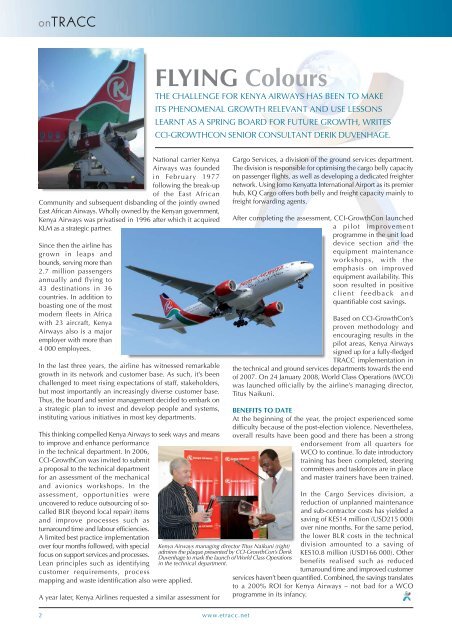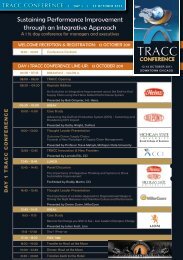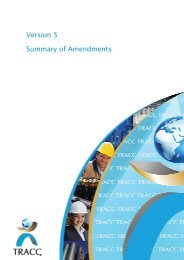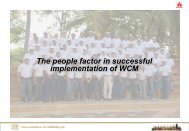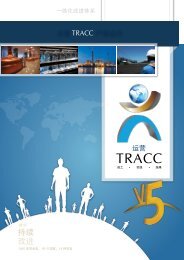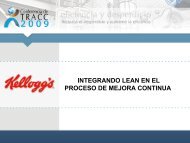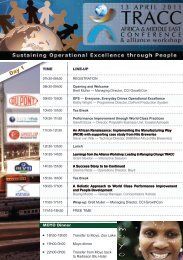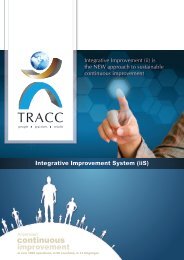WINNING formula - WGLL - TRACC
WINNING formula - WGLL - TRACC
WINNING formula - WGLL - TRACC
Create successful ePaper yourself
Turn your PDF publications into a flip-book with our unique Google optimized e-Paper software.
FLYING Colours<br />
THE CHALLENGE FOR KENYA AIRWAYS HAS BEEN TO MAKE<br />
ITS PHENOMENAL GROWTH RELEVANT AND USE LESSONS<br />
LEARNT AS A SPRING BOARD FOR FUTURE GROWTH, WRITES<br />
CCI-GROWTHCON SENIOR CONSULTANT DERIK DUVENHAGE.<br />
National carrier Kenya<br />
Airways was founded<br />
in February 1977<br />
following the break-up<br />
of the East African<br />
Community and subsequent disbanding of the jointly owned<br />
East African Airways. Wholly owned by the Kenyan government,<br />
Kenya Airways was privatised in 1996 after which it acquired<br />
KLM as a strategic partner.<br />
Since then the airline has<br />
grown in leaps and<br />
bounds, serving more than<br />
2.7 million passengers<br />
annually and flying to<br />
43 destinations in 36<br />
countries. In addition to<br />
boasting one of the most<br />
modern fleets in Africa<br />
with 23 aircraft, Kenya<br />
Airways also is a major<br />
employer with more than<br />
4 000 employees.<br />
In the last three years, the airline has witnessed remarkable<br />
growth in its network and customer base. As such, it’s been<br />
challenged to meet rising expectations of staff, stakeholders,<br />
but most importantly an increasingly diverse customer base.<br />
Thus, the board and senior management decided to embark on<br />
a strategic plan to invest and develop people and systems,<br />
instituting various initiatives in most key departments.<br />
This thinking compelled Kenya Airways to seek ways and means<br />
to improve and enhance performance<br />
in the technical department. In 2006,<br />
CCI-GrowthCon was invited to submit<br />
a proposal to the technical department<br />
for an assessment of the mechanical<br />
and avionics workshops. In the<br />
assessment, opportunities were<br />
uncovered to reduce outsourcing of socalled<br />
BLR (beyond local repair) items<br />
and improve processes such as<br />
turnaround time and labour efficiencies.<br />
A limited best practice implementation<br />
over four months followed, with special<br />
focus on support services and processes.<br />
Lean principles such as identifying<br />
customer requirements, process<br />
mapping and waste identification also were applied.<br />
A year later, Kenya Airlines requested a similar assessment for<br />
Kenya Airways managing director Titus Naikuni (right)<br />
admires the plaque presented by CCI-GrowthCon’s Derik<br />
Duvenhage to mark the launch of World Class Operations<br />
in the technical department.<br />
Cargo Services, a division of the ground services department.<br />
The division is responsible for optimising the cargo belly capacity<br />
on passenger flights, as well as developing a dedicated freighter<br />
network. Using Jomo Kenyatta International Airport as its premier<br />
hub, KQ Cargo offers both belly and freight capacity mainly to<br />
freight forwarding agents.<br />
After completing the assessment, CCI-GrowthCon launched<br />
a pilot improvement<br />
programme in the unit load<br />
device section and the<br />
equipment maintenance<br />
workshops, with the<br />
emphasis on improved<br />
equipment availability. This<br />
soon resulted in positive<br />
client feedback and<br />
quantifiable cost savings.<br />
Based on CCI-GrowthCon’s<br />
proven methodology and<br />
encouraging results in the<br />
pilot areas, Kenya Airways<br />
signed up for a fully-fledged<br />
<strong>TRACC</strong> implementation in<br />
the technical and ground services departments towards the end<br />
of 2007. On 24 January 2008, World Class Operations (WCO)<br />
was launched officially by the airline’s managing director,<br />
Titus Naikuni.<br />
BENEFITS TO DATE<br />
At the beginning of the year, the project experienced some<br />
difficulty because of the post-election violence. Nevertheless,<br />
overall results have been good and there has been a strong<br />
endorsement from all quarters for<br />
WCO to continue. To date introductory<br />
training has been completed, steering<br />
committees and taskforces are in place<br />
and master trainers have been trained.<br />
In the Cargo Services division, a<br />
reduction of unplanned maintenance<br />
and sub-contractor costs has yielded a<br />
saving of KES14 million (USD215 000)<br />
over nine months. For the same period,<br />
the lower BLR costs in the technical<br />
division amounted to a saving of<br />
KES10.8 million (USD166 000). Other<br />
benefits realised such as reduced<br />
turnaround time and improved customer<br />
services haven’t been quantified. Combined, the savings translates<br />
to a 200% ROI for Kenya Airways – not bad for a WCO<br />
programme in its infancy.<br />
2<br />
www.etracc.net


